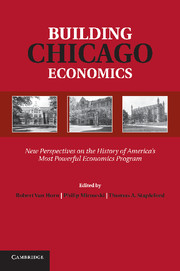 Building Chicago Economics
Building Chicago Economics Book contents
- Frontmatter
- Contents
- Figures and Tables
- Contributors
- Blueprints
- Orientation: In Search of the Chicago School
- Part One Economics Built for Policy: the Legacy of Milton Friedman
- Part Two Constructing the Institutional Foundations of the Chicago School
- Three The Price Is Not Right
- Four Sharpening Tools in the Workshop
- Five George Stigler, the Graduate School of Business, and the Pillars of the Chicago School
- Part Three Imperial Chicago
- Part Four Debating “Chicago Neoliberalism”
- Index
- References
Five - George Stigler, the Graduate School of Business, and the Pillars of the Chicago School
from Part Two - Constructing the Institutional Foundations of the Chicago School
Published online by Cambridge University Press: 05 November 2011
- Frontmatter
- Contents
- Figures and Tables
- Contributors
- Blueprints
- Orientation: In Search of the Chicago School
- Part One Economics Built for Policy: the Legacy of Milton Friedman
- Part Two Constructing the Institutional Foundations of the Chicago School
- Three The Price Is Not Right
- Four Sharpening Tools in the Workshop
- Five George Stigler, the Graduate School of Business, and the Pillars of the Chicago School
- Part Three Imperial Chicago
- Part Four Debating “Chicago Neoliberalism”
- Index
- References
Summary
Introduction
George Stigler is universally regarded as a principal architect of the postwar Chicago School. Gary Becker () recalls Stigler as “Mr. Micro” to Milton Friedman’s “Mr. Macro,” a crucial figure whose stature was equal to that of Friedman in the postwar Chicago School of Economics. Harold Demsetz (, 794) recalls Stigler as having a “penchant for defending and extending [Chicago] neoclassical price theory.” Picking up on this theme, Warren Samuels (in Moss 2002, 642) has characterized Stigler as the “leader” and “principal author” of Chicago Economics, more important in some respects than even Friedman in that he sought to reformulate Chicago price theory “to absorb what hitherto had been excluded.” Similarly, many credit Stigler with extending price theory to industrial organization, regulation, politics, and science (Mincer ; Peltzman ; Diamond 2005). For these reasons, one can agree with the judgment of Melvin Reder (, 10) that Stigler’s arrival at Chicago in 1958 was “key to the development and eventual dominance” of the postwar Chicago School. Yet despite Stigler’s important role at Chicago, there exists evidence that this role is not entirely understood.
Stigler’s relationship to Chicago is very different than those of the other principal architects of the school. He arrived at Chicago much later than Friedman and Aaron Director (who both arrived in 1946). Stigler accepted a joint appointment in the Graduate School of Business (GSB) and the economics department, but was housed in the GSB – a fact the significance of which has never been fully addressed. Finally, during his stay he trained relatively few students. Whereas one often encounters celebrations of Friedman’s influence as a classroom teacher (e.g., Hammond ), the reviews of Stigler as a teacher are mixed at best (Freedman ; Levy in Moss 2002; Sowell 1993). Suffice it to say that whatever Stigler’s influence in the events at Chicago, it could not have operated in precisely the same fashion as that of these other figures.
- Type
- Chapter
- Information
- Building Chicago EconomicsNew Perspectives on the History of America's Most Powerful Economics Program, pp. 116 - 148Publisher: Cambridge University PressPrint publication year: 2011
References
- 19
- Cited by
